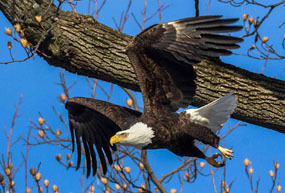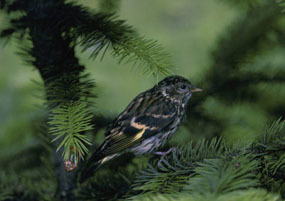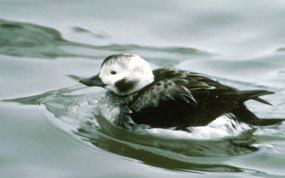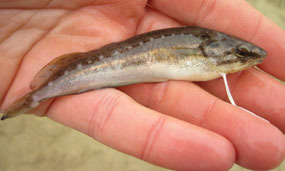Hudson River Almanac 12/30/17 - 1/05/18
The New York State Department of Environmental Conservation sent this bulletin on 01/12/2018 02:00 PM EST |
| DEC Delivers - Information to keep you connected and informed from the NYS Department of Environmental Conservation |
| Share or view as a web page || Update preferences or unsubscribe |
|
|
OVERVIEW Snowy owls were again the feature of the week with as many as seven counted on three separate days. As a backdrop to what appeared to be an irruption of snowy owls, record-breaking cold gripped the watershed. HIGHLIGHT OF THE WEEK 1/3 – Albany County, HRM 153: Early this morning we had four snowy owls present at the Hockey Club Building adjacent to the Albany International Airport. (This was not a record – we had five here at the same time three years ago.) We stationed ourselves in the Hockey Club parking lot at sunrise and within a half-hour we saw two snowy owls flying near the main runways. One flew right at us and we were like the Keystone Cops of bird photography. We had trouble getting cameras ready in time, then having the shutters go. We saw three separate owls sitting on signs and on the ground. Among the other six bird species we saw this morning was a light-phase rough-legged hawk. [The National Oceanic and Atmospheric Administration (NOAA) has reported that the far northern Arctic (the breeding range of the snowy owl) is warming twice as fast as the rest of the globe and this may be having an impact on snowy owls. Their primary forage, small rodents called lemmings, are extremely sensitive to variations in climate. It was once estimated that there were 300,000 snowy owls worldwide, but researchers now conclude that there are fewer than 30,000. In December 2017, snowy owls were listed as “vulnerable,” one step away from endangered, by the International Union for Conservation of Nature (Switzerland). The Associated Press] NATURAL HISTORY ENTRIES 12/30 – Newcomb, HRM 302: The air temperature fell to -24 degrees Fahrenheit (F) today establishing a new record low for the date. The previous record was -13 degrees.
12/30 – Troy, HRM 152: Our Troy Christmas Bird Count was run today for the 69th consecutive year. The weather outside was frightful (-3 degrees F) but seven field parties braved the cold and tallied 70 species, two above our ten-year average. Among the highlights were snow geese (8), common goldeneye (211), hooded mergansers (36), bald eagles (23), rough-legged hawks (6), and an Iceland gull. The total list was remarkable in that there were good numbers of “half-hardy” species eking out a tenuous existence on the northern reaches of their winter ranges. This may prove to be a fatal gamble for many of them as food stocks dwindle through the winter.
[Wilson’s snipe (Gallinago delicata) is a small stocky shorebird that breeds in marshes, bogs, tundra, and wet meadows in the northern U.S. and Canada. They winter along the east coast, the southern U.S., and northern South America. Roger Tory Peterson] 12/30 – Rockland County: The numbers were in for Rockland Audubon Society’s 71st Annual Christmas Bird Count conducted on December 17. Forty-two field counters (plus one “fledgling” counter, less than two years-old) tallied 20,207 birds representing 87 species. While the number of species was among our highest counts (ranking in the 90th percentile since 1947), the number of individual birds only ranked as average (58th percentile since 1947). Highlights included snow bunting, peregrine falcon, merlin, great cormorant, redhead duck, black vulture, and snow goose. The most abundant species were European starling (4,232), Canada goose (4,130), common merganser (1,208), and common grackle (1,203). 12/31 – New Hamburg, HRM 67.5: My wife called me to the window today and said “Hurry, there are ten mute swans swimming in the river in front of our island." At the window I counted not 10, but 14. Wait, four more, 18 swans, a veritable “Swanado” (a technical term describing any number greater than the seven-swans-a-swimming in the Twelve Days of Christmas]. This was a record sighting for us. Usually we see very few swans in the open water of the Hudson, but these were feeding, bottoms up, and fluffing their feathers as they slowly paraded around the perimeter of Rabbit Island. Apparently there was a lush crop of aquatic vegetation this summer because they were joined later by more than 100 assorted Canada geese and ducks all of which were also feeding in the water only fifty feet or so from the southern edge of the Island. [Rabbit Island, the Cullen’s home, is a 1.3-acre island in the river just offshore of New Hamburg. Tom Lake] 12/31 – East Fishkill, HRM 66: I counted 72 wild turkeys in my yard today feeding on seed and enjoying fresh water. We put out seed in three different areas so they were spread out. This was the largest group of turkeys we’ve ever seen.
[Grit is used by grain and seed-eating birds to help in digestion. Fine sand (stone) particles are ingested and move to the gizzard. This is a part of the bird's stomach consisting of very strong muscles that grind tough food. From the gizzard, the food moves to the intestines. Although located in a different part along the digestion path, the gizzard and grit serve the same function as molars do in mammals. Barbara Butler] 1/1 – Saratoga County, HRM 173: I checked out open water at the Lock 4 dam near Stillwater. Canada Geese (1,700) dominated the waterfowl but there were also significant numbers of both hooded and common mergansers, and common goldeneyes. The highlight of the 16 species I counted was two bald eagles, one adult and one immature. 1/1 – Town of Poughkeepsie, HRM 77: On my way back from a snowshoe trek on the Dutchess Rail Trail, a bird in the sky above Morgan Lake caught my eye. Then there was another and I stopped to watch them. At first I thought they were two hawks but their coloring was different. I watched them glide through the sky together, right above me, enjoying the cold flight for about a minute. I came to the conclusion that they were snowy owls! What a way to start off the New Year! 1/1 – Croton Point, HRM 34.5: It was eight degrees F and windy, creating a below zero windchill on our New Year’s Day bird hike. Our highlight was three rough-legged hawks and two northern harriers “working” (hunting) the landfill. [We had a full “Super Moon” on the frigid evening (-5 degrees F) of January 1 that was about 7% larger than the average full moon. Super Moons occur when a full moon coincides with lunar perigee, when the moon is closest to the earth. This week's Super Moon was the second in a rare trilogy of Super Moons: December 3, January 1, and January 31. The full moon of January was also called the Wolf Moon by native Algonquian peoples. Dave Lindemann] 1/2 – Newcomb, HRM 302: When the air temperature fell to -23 degrees F today, it marked the seventh consecutive day when the daily low air temperature fell below zero, averaging -24 degrees. 1/2 – Albany County, HRM 153: I went to the observation deck at the Albany International Airport to see the reported snowy owl and I think I saw it. Later, at the adjacent hockey facility, I spotted a snowy owl perched on the roof. There were children playing in the snow directly beneath it. The owl was watching them but did not appear to be concerned. 1/2 – Albany, HRM 145: When the air temperature fell to -4 degrees F today, it marked the seventh consecutive day when the daily low air temperature fell below zero, averaging -5 degrees. 1/2 – Dutchess County: Several different golden eagles were spotted in Dutchess County today. There was an adult and an immature near Pine Plains and an adult in Dover Plains at the Ten Mile River Preserve. There has also been another immature near Stissing Mountain. In addition, in the last week, there was a golden eagle in Millbrook at Tamarack Pond, another golden eagle in Red Hook, and yet another in Amenia. I would guess that we are dealing with somewhere in the neighborhood of 4-6 individual golden eagles. These birds are still migrating and moving in and out, so they may well be just passing through. 1/3 – New Hamburg, HRM 67.5: Yesterday, four mute swans were sleeping on the river ice today, looking like four white mounds of snow – heads tucked completely under their wings. They stayed that way for hours on the freezing-cold ice then mysteriously disappeared. Today we are tucked in on Rabbit Island for the day while a nor'easter rages outside. Those hours of splitting that tough locust wood paid off.
[The long-tailed duck (Clangula hyemalis) is uncommon in the watershed and seen primarily in migration. They breed in Arctic tundra pools, marshes, and in large mountain lakes. They winter along the east coast of North America and on the Great Lakes. The former common name for long-tailed duck was oldsquaw. Although that name is still found in old field guides, it was dropped from common usage more than a decade ago in favor of long-tailed duck. This was done for several reasons, among which was the negative connotation of the English word and its offensive reference to Native Americans. - Tom Lake] 1/3 – Manhattan, HRM 1: At low tide on a cold winter’s day, we checked our collection gear in Hudson River Park at The River Project's sampling station on the lighthouse tender Lilac at Pier 25. Huge icicles had formed on the shady side of the vessel along each of our trap ropes. We broke them off so they did not threaten the lines holding our gear. Along with the usual suite of invertebrates, we were thrilled to find our first fish of 2018, a juvenile spotted hake (60 millimeters). (Photo courtesy of Natureontheedgenyc.blogspot.com) [Note: one inch = 25.4 millimeters (mm)]
1/4 – Hudson River Watershed: The fortieth annual Mid-Winter Bald Eagle Survey for the Hudson River watershed will be held on January 13. We would like to know if you come upon either bald eagles or golden eagles. Details are always very important, such as where they were, what they were up to, and social behavior (or frequently misbehavior by immatures). Please send us your stories. 1/4 – Hudson River Watershed: A nor’easter turned massive snowstorm, labeled by the National Weather Service as a “bomb cyclone,” pounded the lower estuary. Given the duration of wind speeds, visibility, and the foot of snow, blizzard conditions were observed in several places in the Lower Hudson Valley as well as Long Island, and New York City. [The term "bomb cyclone" is used by meteorologists to refer to a rapidly intensifying area of low pressure. In this instance, with a nor’easter, cold air from Canada combined with warmer ocean waters of the Gulf Stream to trigger an explosive strengthening pattern. The central pressure of an area of low pressure (a winter storm) must drop at least 24 millibars in 24 hours to create a bomb cyclone (a millibar is the measurement of atmospheric pressure). National Oceanic and Atmospheric Administration] [A blizzard is defined as: sustained winds or frequent gusts greater than or equal to 35 mph; considerable falling and /or blowing snow, and visibility frequently reduced to less than ¼ mile, that occurs for three hours or more. National Weather Service]
1/5 – Newcomb, HRM 302: Bitter cold air temperatures continued this week with the overnight average being -16 degrees F. We received just an inch of snow from the nor’easter but wind gusts up to 37 miles-per-hour (mph) created lethal windchill nearing 75 mph. The river was completely frozen over this morning. 1/5 – Minerva, HRM 284: In late afternoon the dogs and I returned from the “back forty,” me on snowshoes, the dogs without. We made it to the swamp through 15 inches of snow, but the weather was dangerous and the windchill felt deadly. The air temperature was -10 degrees F. and the wind was gusting to 30 mph creating a windchill of about -50 degrees. The white-tailed deer highways were well-traveled and the trees were “talking up” a storm! But it was cold – our 20 minutes out there was plenty. [“Back forty” is a colloquial expression meant to convey wild or rough terrain adjacent to a developed area. In the instance of a farm, for example, it might be a small percentage of the land left uncultivated or natural, frequently in the “back forty acres” of the property. Tom Lake] 1/5 – Cheviot, HRM 106: As I looked out the door today I saw something I had never seen before. An adult bald eagle snatched a Canada goose in mid-flight, both dropping like a stone to the icy surface of the river. It happened with such force! By then I had grabbed the field glasses and watched as the eagle attacked the goose, the goose’s wings flapping wildly. Within minutes, however, the drama was over. The goose was motionless and the eagle was feeding on it with its efficient beak, its talons holding the bird in place. Not long after another adult eagle (its mate?) arrived to share in the meal. After they had their fill, they left and three immature bald eagles arrived to have a go at the leftovers. This all reminded me how difficult survival is in frigid weather, and what expert hunters our bald eagles are. [Bald eagles taking geese along the estuary is not common. Ducks and fish are far easier targets. Pete Nye talks of bald eagles on the Catskill Mountain reservoirs knocking down geese and then holding their heads underwater to drown them. Tom Lake] 1/5 – Hudson River Watershed: The New York State Ornithological Association’s Winter Waterfowl Count will be held the weekend of January 13-14. This annual statewide count includes waterfowl and their allies as well as eagles. Data collected will aid in understanding population trends and conservation practices of Atlantic Flyway waterfowl. If you would like to participate, or want more information, contact NYSOA: http://www.nybirds.org/ProjWaterfowl.htm.
WINTER 2018 NATURAL HISTORY PROGRAM Saturday, February 24 - 1:00 p.m.
The Hudson is measured north from Hudson River Mile 0 at the Battery at the southern tip of Manhattan. The George Washington Bridge is at HRM 12, the Tappan Zee 28, Bear Mountain 47, Beacon-Newburgh 62, Mid-Hudson 75, Kingston-Rhinecliff 95, Rip Van Winkle 114, and the Federal Dam at Troy, the head of tidewater, at 153. The tidal section of the Hudson constitutes a bit less than half the total distance – 315 miles – from Lake Tear of the Clouds to the Battery. Entries from points east and west in the watershed reference the corresponding river mile on the mainstem. TO CONTRIBUTE YOUR OBSERVATIONS OR TO SUBSCRIBE The Hudson River Almanac is compiled and edited by Tom Lake and emailed weekly by DEC's Hudson River Estuary Program. Share your observations by e-mailing them to trlake7@aol.com. To subscribe to the Almanac (or to unsubscribe), use the links on DEC's Hudson River Almanac or DEC Delivers web pages. Discover New York State Conservationist - the award-winning, advertisement-free magazine focusing on New York State's great outdoors and natural resources. Conservationist features stunning photography, informative articles and around-the-state coverage. Visit the Conservationist webpage for more information. USEFUL LINKS National Oceanic and Atmospheric Administration online tide and tidal current predictions are invaluable when planning Hudson River field trips. For real-time information on Hudson River tides, weather and water conditions from twelve monitoring stations, visit the Hudson River Environmental Conditions Observing System website. Information about the Hudson River Estuary Program is available on DEC's website at http://www.dec.ny.gov/lands/4920.html . Smartphone app available for New York outdoor enthusiasts! Copies of past issues of the Hudson River Almanac, Volumes II-VIII, are available for purchase from the publisher, Purple Mountain Press, (800) 325-2665, or email purple@catskill.net |

 Hudson River Almanac
Hudson River Almanac  12/30 – Montgomery County, HRM 157: As the Mohawk River at Fultonville was freezing over leaving less open water, raptors were concentrating in just a few areas. We counted four bald eagles on our visit today, two adults and two immatures. The four of them were skirmishing over something; the darker of the two immatures was mantling over it as crows pestered them. A dead Canada goose lay dead on the ice not far away. We headed over to Schoharie Crossing, about four miles east along the Mohawk, where we found two more adult bald eagles and a golden eagle that we had seen once before. (Photo of a Bald Eagle courtesy of Bob Rightmyer)
12/30 – Montgomery County, HRM 157: As the Mohawk River at Fultonville was freezing over leaving less open water, raptors were concentrating in just a few areas. We counted four bald eagles on our visit today, two adults and two immatures. The four of them were skirmishing over something; the darker of the two immatures was mantling over it as crows pestered them. A dead Canada goose lay dead on the ice not far away. We headed over to Schoharie Crossing, about four miles east along the Mohawk, where we found two more adult bald eagles and a golden eagle that we had seen once before. (Photo of a Bald Eagle courtesy of Bob Rightmyer) 12/30 – Cold Spring, HRM 53: We spotted a brown shorebird with a long bill at Foundry Cove today. It gave us a fleeting look when it flushed but quickly flew out of view. We all thought it was a Wilson’s snipe but we were unable to re-locate the bird. We wanted to be conservative in our estimate so we agreed on calling it “shorebird sp.” Later, at Constitution Marsh Sanctuary just south of Foundry Cove, where Indian Brook empties into the marsh, we had excellent views of a feeding Wilson’s snipe, probing in the small patch of open water. It had been years since a Wilson’s snipe had been seen on the Putnam Highlands Christmas Bird Count. (Photo of Wilson's snipe courtesy of the National Fish and Wildlife Service)
12/30 – Cold Spring, HRM 53: We spotted a brown shorebird with a long bill at Foundry Cove today. It gave us a fleeting look when it flushed but quickly flew out of view. We all thought it was a Wilson’s snipe but we were unable to re-locate the bird. We wanted to be conservative in our estimate so we agreed on calling it “shorebird sp.” Later, at Constitution Marsh Sanctuary just south of Foundry Cove, where Indian Brook empties into the marsh, we had excellent views of a feeding Wilson’s snipe, probing in the small patch of open water. It had been years since a Wilson’s snipe had been seen on the Putnam Highlands Christmas Bird Count. (Photo of Wilson's snipe courtesy of the National Fish and Wildlife Service) 1/1 – Newcomb, HRM 302: We have been experiencing extremely cold weather this past week (fourth straight day of record low air temperatures). Despite the frigid air, there was still some open water on the Hudson River at the Route 28N bridge. I could see from tracks in the snow that a few white-tailed deer had been brave enough to cross the river where the ice was solid. With just over 14 inches of snow on the ground, the local feeder birds were dominated by dark-eyed juncos, American goldfinches, and pine siskins. I did spot a single American robin today along with one evening grosbeak. Black-capped chickadees, brown creepers, and woodpeckers were also in the mix. Snow buntings and red crossbills were “gritting” along the sides of the roadways. (Photo of pine siskin courtesy of National Fish and Wildlife Service)
1/1 – Newcomb, HRM 302: We have been experiencing extremely cold weather this past week (fourth straight day of record low air temperatures). Despite the frigid air, there was still some open water on the Hudson River at the Route 28N bridge. I could see from tracks in the snow that a few white-tailed deer had been brave enough to cross the river where the ice was solid. With just over 14 inches of snow on the ground, the local feeder birds were dominated by dark-eyed juncos, American goldfinches, and pine siskins. I did spot a single American robin today along with one evening grosbeak. Black-capped chickadees, brown creepers, and woodpeckers were also in the mix. Snow buntings and red crossbills were “gritting” along the sides of the roadways. (Photo of pine siskin courtesy of National Fish and Wildlife Service) 1/3 – Croton Point, HRM 34: A female or hen long-tailed duck was swimming close to the river side of Croton Point. These are true sea ducks and are far more common in Long Island Sound than in the estuary. The lone long-tail joined a group of slightly smaller buffleheads in deeper water making multiple displays by tilting on its head with tail straight up. Long-tails dive distinctively by using their wings. (Photo of long-tailed duck courtesy of National Fish and Wildlife Service)
1/3 – Croton Point, HRM 34: A female or hen long-tailed duck was swimming close to the river side of Croton Point. These are true sea ducks and are far more common in Long Island Sound than in the estuary. The lone long-tail joined a group of slightly smaller buffleheads in deeper water making multiple displays by tilting on its head with tail straight up. Long-tails dive distinctively by using their wings. (Photo of long-tailed duck courtesy of National Fish and Wildlife Service) 
 1/4 – Yonkers, HRM 18: Our spirit was willing but there was just too much ice along the river at the Center for the Urban River at Beczak. Our “off-season” seining program had to take a break, probably for a while. (Photo of Tappan Zee ice courtesy of Elisa Caref)
1/4 – Yonkers, HRM 18: Our spirit was willing but there was just too much ice along the river at the Center for the Urban River at Beczak. Our “off-season” seining program had to take a break, probably for a while. (Photo of Tappan Zee ice courtesy of Elisa Caref)